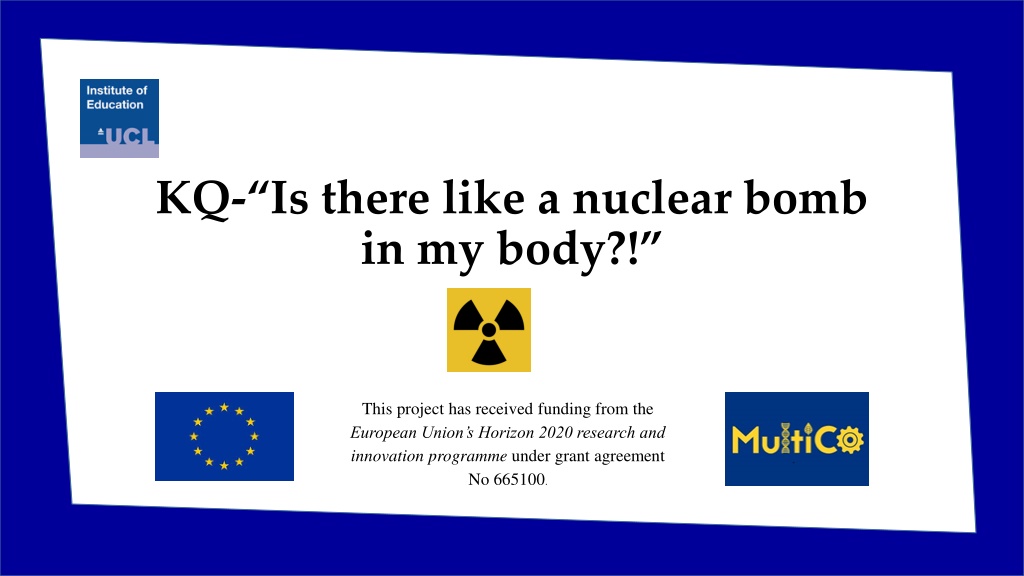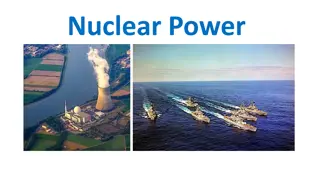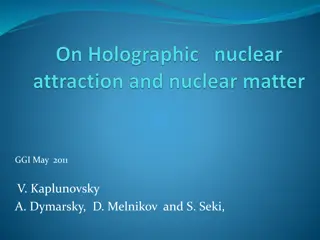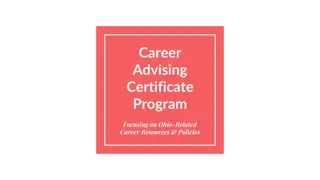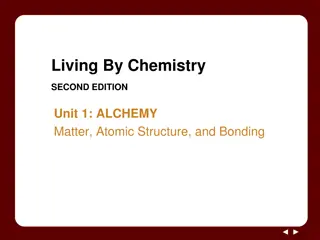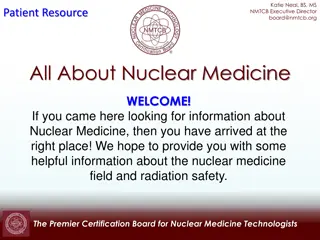Exploring Nuclear Medicine: Career as a Nuclear Medicine Technologist
Nuclear medicine is a vital field in medical imaging and treatment, utilizing radioactive tracers to diagnose and treat diseases. Becoming a Nuclear Medicine Technologist involves specialized training, patient care, and operating imaging equipment to create detailed images of the body. Safety, radiation protection, and practical skills are essential for this rewarding healthcare career.
Download Presentation

Please find below an Image/Link to download the presentation.
The content on the website is provided AS IS for your information and personal use only. It may not be sold, licensed, or shared on other websites without obtaining consent from the author. Download presentation by click this link. If you encounter any issues during the download, it is possible that the publisher has removed the file from their server.
E N D
Presentation Transcript
KQ-Is there like a nuclear bomb in my body?! This project has received funding from the European Union s Horizon 2020 research and innovation programme under grant agreement No 665100.
KQ-Is there like a nuclear bomb in my body?! Starter- Jot down everything you think you know about radiation TIF- Radiation is always harmful Evaluate this statement This project has received funding from the European Union s Horizon 2020 research and innovation programme under grant agreement No 665100.
What is Nuclear Medicine? Nuclear Medicine is a diagnostic medical imaging and treatment speciality. It combines elements of anatomy and physiology, chemistry, physics, mathematics and computing with patient care skills. Radioactive tracers are administered to patients in order to diagnose and /or treat disease. Nuclear Medicine differs from other imaging techniques such as X-ray by giving information about the function of parts of the body, as well as their structure. The use of these radioactive tracers is closely monitored. The techniques are very safe both for the patient and for the technologist. What type of person is suited to a career as a Nuclear Medicine Technologist? A wide variety of people would be suited to a career as a Nuclear Medicine Technologist. The most important factor is an ability to work and communicate well with people. While knowledge of science obviously plays an essential part, practical skills including patient care and interpersonal skills are equally important. So what is nuclear medicine? I have underlined some tricky phrases What do you think these
Nuclear Medicine Technologist How do you train to become a nuclear medicine technologist? There are two main routes to qualification as a Nuclear Medicine Technologist. You can choose a four year part-time BSc in Clinical Technology with specialisation in Nuclear Medicine during the degree. This is combined with training based upon formal practical experience in Nuclear Medicine. The other route is to take a BSc in Radiography, which takes three years, and then specialise in Nuclear Medicine, after first qualifying as a Radiographer. Practical experience can be obtained by working in a nuclear medicine department in hospital.
So what does the job involve? Nuclear medicine technologists typically do the following: Explain imaging procedures to the patient and answer questions Follow safety procedures to protect themselves and the patient from unnecessary radiation exposure Examine machines to ensure that they are working properly Prepare radioactive drugs (radiopharmaceuticals) and administer them to the patient Monitor the patient to check for unusual reactions to the drugs Operate equipment that creates images of areas in the body, such as images of organs Keep detailed records of procedures Follow radiation disposal and safety procedures Remember there are dangers to radiation source !!!!! Think pair share: What skills might a NMT need?
Dealing with patient fears One of the skills required is being able to deal with patient concerns in a sensitive manner. Watch the start of the following video and then discuss how Deepa handles the patient s concerns. https://www.youtube.com/watch?v=-vDmlAN1B-g Can you give Deepa a few tips to help her calm the patient down?
Devise a role play for a Nuclear Medicine Technologist and her patient What is your PAFT? Rules Work in pairs Each take a role Write a script Ensure you clearly discuss the science, the benefits and risks, include language that is appropriate to your part ANY QUESTIONS
KQ-Is there like a nuclear bomb in my body?! 2 Radiopharmaceuticals STARTER- Read the information below and then rewrite it as best you can so a year 7 could understand it Radioactive drugs, known as radiopharmaceuticals, give off radiation, allowing special scanners to monitor tissue and organ functions. Abnormal areas show higher-than-expected or lower- than-expected concentrations of radioactivity. Physicians and surgeons then interpret the images to help diagnose the patient s condition. For example, tumours can be seen in organs during a scan because of their concentration of the radioactive drugs. TIF- Are radioactive drugs safe? WHAT DO YOU THINK?
Uses of radiopharmaceuticals Radiopharmaceuticals can be used either for diagnostic or therapeutic (treatment) purposes. It is made up of a radioactive substance bonded to another molecule. This molecule carries the radioactive substance to specific organs, tissues or cells. The radioactive substance is selected according to the type of radioactive particle emitted. Use your common sense to suggest what characteristics the radioactive substance should have . Would their characteristics need to be different if they were either diagnostic (working out what s wrong with you) OR therapeutic procedures (treating what s wrong with you) therapeutic mid-term, stay in the body slightly longer diagnostic short term, get in the body easily and out body easily
Diagnosticradiopharmaceuticals Radioactive substances emitting penetrating rays (called gamma rays) are used for diagnostic (imaging) where the radiation has to escape the body before being detected by a specific device (special cameras). Typically, the radiation emitted by the Radioactive substances used for imaging vanishes completely after 1 day through radioactive decay and normal body excretion. why is this important?
Therapeuticradiopharmaceuticals Radioactive substances emitting short range particles (called alpha or beta particles) are used for therapy due to them losing their power over a very short distance, therefore causing a lot of local damage (such as cell destruction). This characteristic is used for therapeutic purposes: cancer cells destruction, pain treatment in palliative care for bone cancer or arthritis. Such Radioactive substances stay longer in the body than imaging ones; this is intentional in order to increase treatment efficiency, but this remains limited to several days.
So back to Deepa.. Nuclear Medicine Technologists need to be able to prepare and administer the radioactive tracers. But .
Which Radioactive substance would Deepa use for diagnosis and which one for treatment of the thyroid? Iodine 123 or Iodine 131? But first What does half life mean?? I-131 -half life of 8 days I-123 - half life of 13 hours
Typical radiopharmaceuticals - Fill in the table Diagnostic Therapeutic
